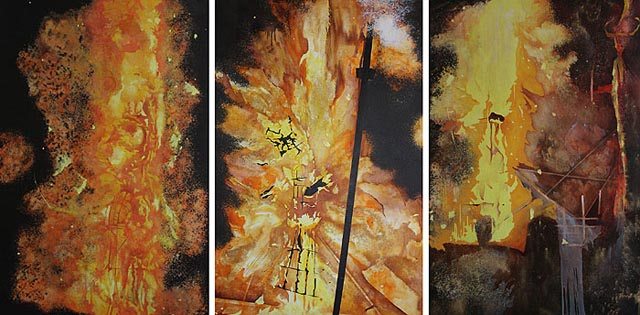
Malleable Memory: Artists and their Truth
We are a simmering bundle of the past, the present and our hopes and anxieties about the future – what we remember and what we choose to forget becomes the world around us. Memories often trespass from locked rooms and forbidden places in the mind into the present. Some of them become the scaffolding for art, for the truths artists want to share through their work. Yet seen through the distancing telescope of memory, how true is truth? Can something as subjective as the creation of art be objective in truth-telling?
In Malleable Memory at the Aicon Gallery several artists come together cutting across borders, and participate in a fascinating exercise in telling their version of the truth, anchored in personal memories.
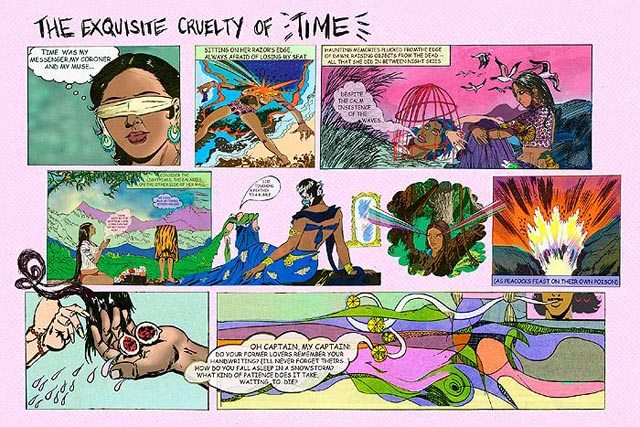
Malleable Memory, curated by Nitin Mukul, features works by Jaishri Abichandani, Eric Ayotte, Shelly Bahl, Ruby Chishti, Mike Estabrook, Chitra Ganesh, Gisela Insuaste, Mala Iqbal, John Jurayj, Jen Liu, Naeem Mohaiemen, Sandeep Mukherjee, Nitin Mukul, Anjali Srinivasan, and Jaret Vadera. As the names of the artists suggest, in this group show the art has traveled across international borders to unravel the commonality of the human experience.
To walk through the gallery is to see many lives and the juxtapositions of memory on everyday realities. All these artists bring their past, their perceptions into this show. Even passing comments, remembered childhood hurts can find their way into the creative process and become part of a meaningful dialogue with viewers.
“To question the existing norms that somehow affect our lives, how these are formed, penetrates and become an absolute truth in the society has been one of the strong motives of my work,” says Ruby Chishti
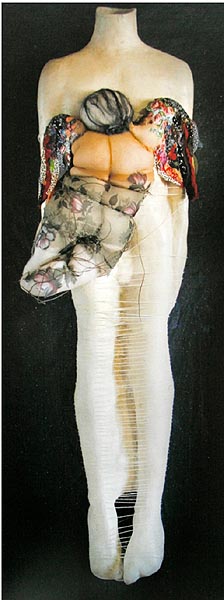
Malleable Memory: Dying Young
Her work ‘My birth will take place a thousand times no matter how you celebrate it’ is a very personal one. “Born as a fourth daughter in my family who were waiting for a son, I was always reminded by my grandmother how my family received the depressing NEWS of my birth, everyone cried, and my father did not take the meal that day. Growing up with these thoughts had always raised doubts about the beliefs.”
The griefs and heartbreaks that we endure often become the underpinnings of creative work. In another work, Chishti’s title “....and then I buried my pride along with you...” is taken from a poem by her brother who died at a young age and who himself had written it for a father who died young. “But I used it in a different context which is related to my own experience as a woman raised in a society where it very common to expect to cease a woman’s life in an unfortunate situation when something happens to her male counterpart,” says Chishti
“I experience a different reality here in United States that made me think of creating this particular work, a woman’s life would not end with a protected shell that male-dominated society believes in … but again which version of reality is to be considered the right one?”
Nitin Mukul’s powerful triptych titled Celebration leaves you a bit off-kilter because the immediate perception it evokes is of some major disaster as orange flames spew out of the canvases. Yet it is about the burning of the giant effigies of the demon Ravana and his two brothers – central to the celebration of Dusshera, the triumph of good over evil.
Mukul’s personal memories serve as a reference point and he has based the artwork on 100’s of photos that he took. And as you look at it, you cannot help thinking of ominous events. As Mukul points out, “The impact and cathartic energy captured in the paintings also triggers associations with our collective consciousness of mass media events; war, environmental disaster. Things are not always what they appear to be. What I want people to do is map their own feelings about the work, their own perceptions.”
Chitra Ganesh’s ‘The Exquisite Cruelty of Time’, for example, evokes memories of the time when the truth we lived by was the one of the comic book universe, when what we saw within those action-packed multicolored pages was real, and hence true. An enthralling story-teller, Ganesh distills her own truths about feminism, about the social and political world into the engrossing world of myth, folklore and comic books, subverting the genre to reveal her own truths.

Malleable Memory: Reconciliations
As we move between several worlds in our global age, Jaishri Abichandani’s image of Silicon Valley, Bangalore is particularly striking as it blends the two cities together – and to the casual observer it looks like the authentic thing. Isn’t that how our lives are now, increasingly split between cities, countries and cultures?
This is a part of a series called Reconciliations and uses appropriated images from the Internet, merging different international cities together and weaving a fabricated world. In these dramatic images, scoffing at borders, very different cities are locked in an embrace – Ramallah and Jersulaem, New York and Tokyo, Lima and Santiago. In her portrait of Bombay and London, she shows the slums in both places, in a way upsetting the neat preconceptions we may have of London the cosmopolitan city, and the epicenter of the once mighty British Raj. She says, “It’s really exploring what’s going on in the world today.”
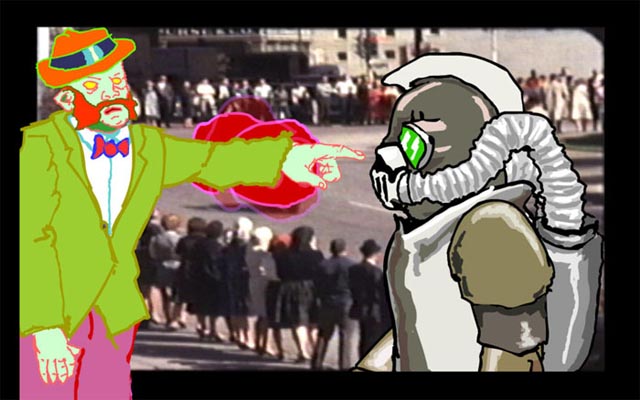
Malleable Memory: Cultural imagination
Michael Estabrook, who has been to India a few times, is originally from Illinois and it is his memories that you see in his video work, ‘What do Sleeping Monsters do for Reason?’, superimposed on the collective cultural memory of Americana. He combines footage of the JF Kennedy assassination and works in animated monsters into it.
“I work with my imagination juxtaposed into a larger cultural imagination,” he says. “What I’m trying to determine is what exactly makes us have our own imaginations, makes us all individuals versus just sharing this huge, mass media global wellspring of imagination. Each person’s experience is different and each of us reacts differently.”
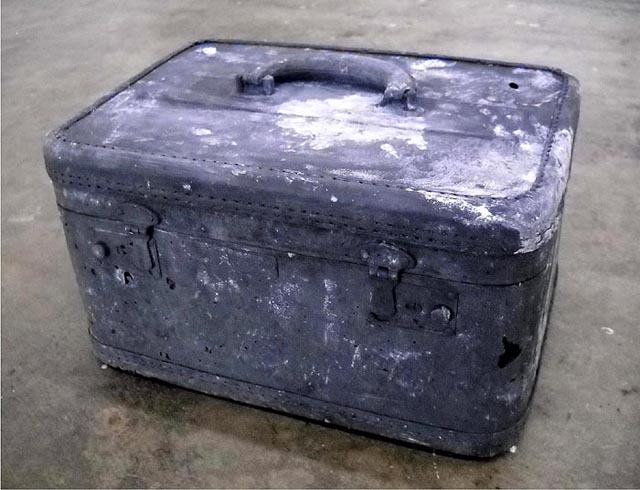
Malleable Memory: Fragmentation
Then there is John Jurayi’s “Untitled (Mirror Image)” which startles you and makes you somewhat uncomfortable. Best described in Jurayi’s words, “They use reflection, duplication and fragmentation to hijack the author and the viewer into historical events. Representation is radically obstructed and debased by the appearance of the image; the “Social Spectacle” becomes violence as social theater.”
Equally disturbing is his other work – foreboding looking, abandoned luggage which makes you think of terror plots and hijackings. He says, “The luggage pieces cast from gunpowder inscribes the personal object with a violent potential reflective of world travel in the present. The viewer, standing in the now is confronted with a detournement of the modern romantic consumer object (luggage), while the real has gone missing.”
To enter the anteroom at the Aicon Gallery is to enter yet another world within a world, the mind of artist Shelly Bahl who has recreated a fictional, fabricated world, appropriating the lives and idiosyncrasies of four different actresses of the past, who all lived real lives of pretense, of posing as who they were not. Stitching aspects of their lives Bahl gives us Parveen Banu – someone who seems so real that you’re almost sure you’ve read about her in some gossip magazine or have seen some of her movies. Through installations, videos, photography and stills she lays the bricks of the life of this imaginary woman, fictional clues dropped into real events until you believe it all – almost.
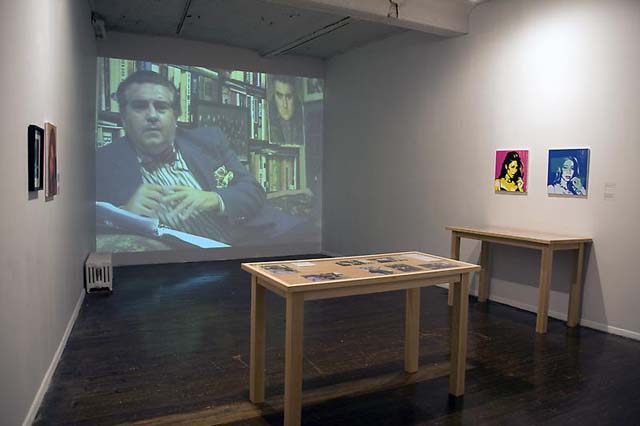
Malleable Memory: Fiction, Fabrication
Bahl, who grew up on a voracious diet of Hindi cinema, juxtaposes Bollywood with opera, video and miniature paintings to make a larger statement about the absurd and fantastic nature of real life. After all, isn’t life all Maya or Illusion – so what is true and what is not?
“I think the need to redefine art after 9/11 and geographical dispersal has made the art world quite complex,” says Chishti. “Artists are dealing with much broader questions like identity, time, ethics, history and globalization. So their issues are common yet personal, and to access to the world on your fingertips and to the rest of the artists, the influence and interaction is obvious.”
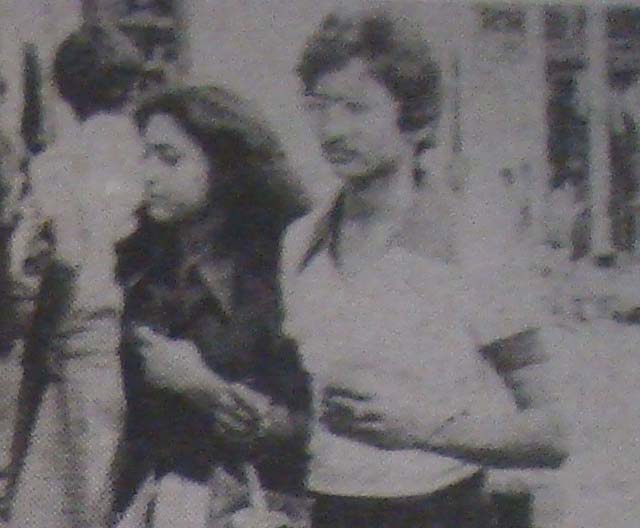
Malleable Memory: Rambling, Looping, Meandering
Naeem Mohaiemen’s ‘Afsan’s Long Day’ is a single channel video, a short excerpt from a research project that he’s been working on for few years now, about radical left movements and the twilight moment for a push to utopia. “It’s a rambling project in many segments and platforms, over many years, and that looping, meandering process has worked well for me,” he says.
So is the art world getting more flattened where artists are free to dabble in influences from all over and are also interact with artists from all over? ”People were always free to enter at an angle,” says Mohaiemen. “Structurally, that has accelerated from the entry of new disciplines such as historiography and architecture. A little less market madness and bubble collecting would probably help create even more conducive environments.”
And what of ‘mainstream audiences’? Are they more receptive to this more ‘difficult’, more cerebral art which is not always pretty to look at?
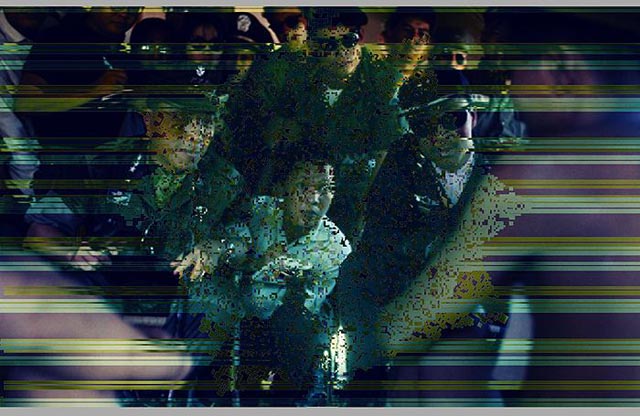
Malleable Memory: Unknown, Unstable
“ When I think of the term ‘mainstream audience’ and the art world, I have a hard time reconciling the two, unless you think of visitors to, say the National Gallery in DC or the MoMA, but not the gallery scene,” says Mukul. “So I guess my answer at this point is no, and that’s because there really isn’t a mainstream audience for this type of work yet, but that could change over time.”
John Jurayi puts it a bit more darkly. “The art world has become disturbingly conservative and fear-based around what it is willing to represent,” he says. “Work that truly engages both politically and formally the complicated, rich and terrifying realities of our times is bypassed for safer, more decorative work that is easier to digest, easier to sell to collectors who want easy, easy, easy. The unknown and the unstable would turn this market-driven art world upside down and release art which would be an unvarnished mirror of who we are.”
Mohaiemen points out that at the the lowest point of the recent market crashes, when New York stores didn’t have tenants, some temporarily allowed their spaces to be taken over by roving art projects. This may have been a short-lived phenomenon but he feels it was a healthy break from the make-to-sell conveyor belt ethos.
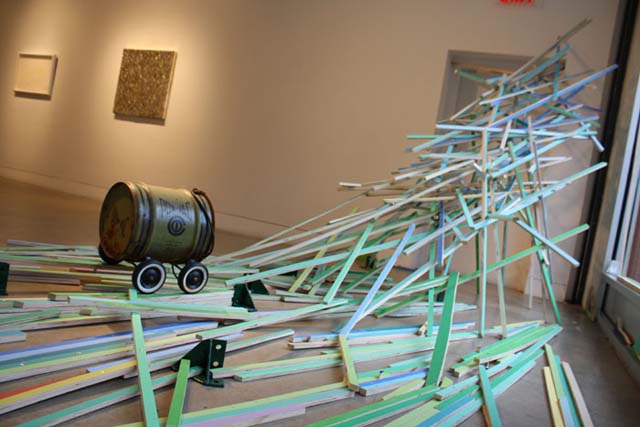
Malleable Memory: Transcending Borders
One noteworthy aspect of the show is that it seems to have transcended the Indian or South Asian label to attempt a more ambitious gathering of artists across borders, with a mix of South Asian, Latino, Chinese and Caucasian artists – making their ethnicity irrelevant. Mukul believes that there is some momentum building towards a more inclusive approach in the commercial arena. He feels that shows based on identity politics are fine, so long as they don’t become a reason for pigeon-holing south Asian artists in their own slot.
“However, I sometimes get exasperated by seeing so many shows based on the ethnicity of artists, especially when major institutions can’t even get the designation right.” He points to a major show in London titled ‘The Empire Strikes Back: Indian Art Today’, which included Pakistani and other artists of the South Asian Diaspora who were being generically labeled Indian.
“I think it’s time to see South Asian artists as being just part of the bigger family of artists driven by conceptual concerns and the quality of the work, rather than by ethnic identity politics and cultural issues,” he says. “It’s happened here because that’s what I wanted to do and I’m glad Aicon Gallery was receptive to do that. I would like to think that what we are doing is part of a paradigm shift of some kind.”
(C) Lavina Melwani
Photographs courtesy: Aicon Gallery
Curator’s note:
Nitin Mukul on Malleable Memory.
Truth is elusive, motivated by self-preservation. In the film Rashomon (1950) by Akira Kurosawa, various eyewitnesses describe their recollections of a violent crime. The accounts and their outcomes vary, leaving viewers to weigh each version against another. In the process the characters’ stories collectively show the nature of truth as unstable and always susceptible to being shaped. Indeed, we have built-in survival mechanisms that may lead us to selectively edit or even invent memories to forge ‘objectivity.’ Besides showing the often self-centered nature of people, the film suggests a multitude of perspectives is necessary, objectivity impossible.
In a similar spirit, this show calls upon a diverse range of artists and media. Taken together, they reveal a variety of positions, a multiplicity of voices drawing upon their own memories, expressing their own truths. Each has a kind of accuracy, yet are often at odds with grand narratives and official accounts, undercutting neatly kept categories and borders. Through the various mediums, these artists examine the conceptions and expectations of reality each with their own unique interpretation. They present to us the idea of memory as a continuous and multifaceted representation in a constant state of flux. What emerges is a kind of objectivity that rests less upon tangible reference points, but rather associative recollections. Whether appropriated and reconfigured from popular sources, or registered as pigment on a surface, works in this show explore the crafting of reality, and how memory serves us.
(This exhibition runs from 22 July – 4 September 2010 at the Aicon Gallery.)
